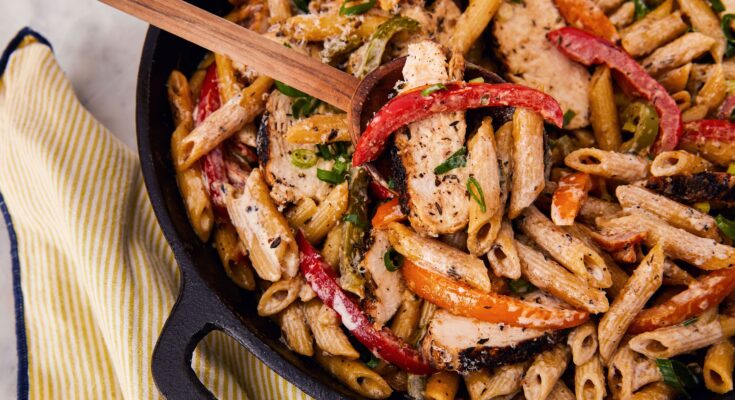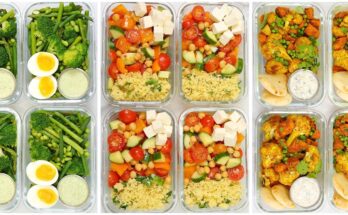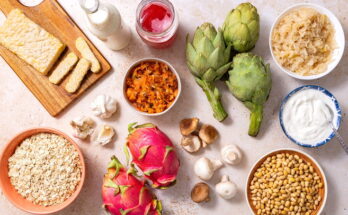Rasta Pasta Recipe: Rasta Pasta is a vibrant, flavorful dish that blends Caribbean spices with creamy pasta goodness. It’s a delightful fusion of cultures, with its name inspired by Rastafarian culture. Traditionally, the dish includes jerk-seasoned proteins, colorful bell peppers, and a creamy sauce that perfectly balances heat and richness.
Why You Should Try Rasta Pasta
Rasta Pasta is a one-of-a-kind culinary experience. The dish offers:
- A Symphony of Flavors: From the smoky jerk seasoning to the creamy sauce, every bite is a flavor explosion.
- Incredible Versatility: You can customize it to suit dietary needs or personal preferences.
- Cultural Depth: It’s more than a meal—it’s a celebration of Caribbean heritage.
Whether you’re a pasta lover or a spice enthusiast, Rasta Pasta has something for everyone.
Key Ingredients for Rasta Pasta
To make Rasta Pasta, gather the following:
- Pasta: Penne or fettuccine work best.
- Protein: Chicken, shrimp, or tofu.
- Vegetables: Bell peppers (red, green, yellow), onions, garlic.
- Creamy Sauce: Heavy cream, Parmesan cheese, and jerk seasoning.
- Jerk Seasoning: The heart of the dish, a blend of allspice, thyme, and Scotch bonnet peppers.
Substitutions:
- Swap heavy cream for coconut milk for a tropical twist.
- Use gluten-free pasta for dietary preferences.
Tools You’ll Need
- A large pot for boiling pasta.
- A skillet for cooking the protein and sauce.
- A sharp knife and cutting board.
- A whisk for blending the sauce.
- Measuring cups and spoons for precise seasoning.
Preparing your tools beforehand makes the cooking process seamless.
Preparing the Ingredients
- Vegetables: Thinly slice bell peppers and onions. Mince garlic for a burst of flavor.
- Protein: Marinate chicken, shrimp, or tofu with jerk seasoning for at least 30 minutes.
- Seasoning: Keep additional spices like black pepper, paprika, and salt handy for adjustments.
Making the Creamy Sauce
- In a skillet, melt butter or heat olive oil.
- Sauté minced garlic until fragrant.
- Stir in heavy cream and simmer for a few minutes.
- Gradually add Parmesan cheese, whisking until the sauce thickens.
- Season with jerk seasoning for that signature flavor.
Cooking the Pasta
- Boil water with a pinch of salt and a dash of oil.
- Cook pasta until al dente, following package instructions.
- Drain and set aside, reserving a cup of pasta water for the sauce if needed.
Cooking the Protein
- Heat oil in a skillet.
- Cook marinated protein until fully cooked (chicken should reach an internal temperature of 165°F).
- Remove and set aside, keeping it warm.
Assembling the Dish
Now comes the exciting part—bringing everything together!
Combine Pasta and Sauce:
- Add the cooked pasta to the skillet with the creamy sauce.
- Toss well to ensure every piece of pasta is coated in the rich, jerk-flavored sauce.
Incorporate Vegetables:
- Toss in the sautéed bell peppers and onions.
- Stir to combine, allowing the vegetables to retain a slight crunch for texture.
Add Protein:
- Gently fold in your cooked protein (chicken, shrimp, or tofu) so it absorbs the sauce’s flavor.
- If the dish seems too thick, add a splash of reserved pasta water to achieve the desired consistency.
Garnishing Your Rasta Pasta
Finish your Rasta Pasta with the perfect garnish:
- Sprinkle freshly chopped parsley or cilantro on top for a pop of color and herbal aroma.
- Add a few extra grates of Parmesan cheese for indulgence.
- If you love spice, top it with finely chopped Scotch bonnet peppers or a drizzle of jerk sauce.
Presentation is everything—serve your dish in a large, vibrant bowl to highlight its colorful ingredients.
Serving Suggestions
Pair your Rasta Pasta with complementary sides and drinks for a complete meal:
- Salad: A crisp green salad with a light vinaigrette balances the rich pasta.
- Bread: Garlic bread or crusty rolls are perfect for mopping up the creamy sauce.
- Drinks: Serve with a tropical drink like a rum punch or a refreshing lemonade.
Rasta Pasta is ideal for weeknight dinners, casual gatherings, or even a special date night at home.
Tips for Customizing Your Rasta Pasta
Rasta Pasta is endlessly customizable. Here’s how to make it your own:
- Vegan Version: Use coconut milk instead of heavy cream and nutritional yeast instead of Parmesan. Swap protein for chickpeas or tempeh.
- Gluten-Free: Use gluten-free pasta and ensure any store-bought seasonings are gluten-free.
- Extra Spicy: Add more jerk seasoning or diced Scotch bonnet peppers for a fiery kick.
- Unique Ingredients: Experiment with pineapple chunks for a sweet-and-savory twist or sprinkle toasted coconut on top.
Common Mistakes to Avoid
Even a simple dish like Rasta Pasta has pitfalls. Here’s what to watch out for:
- Overcooking Pasta: Pasta should be al dente to avoid becoming mushy when mixed with the sauce.
- Underseasoning: Rasta Pasta relies on bold flavors, so don’t skimp on jerk seasoning or other spices.
- Overloading Sauce: Too much sauce can overpower the other ingredients. Aim for balance.
Storing and Reheating Rasta Pasta
Leftovers? No problem!
- Storing: Place the pasta in an airtight container and refrigerate for up to 3 days.
- Reheating: Warm in a skillet over medium heat, adding a splash of milk or water to loosen the sauce.
Avoid microwaving if possible—it can dry out the pasta and make the sauce split.
FAQs about Rasta Pasta Recipe
1. What is Rasta Pasta?
Rasta Pasta is a vibrant, flavorful dish that combines pasta with a creamy, spicy sauce and a Caribbean twist. Typically, it features jerk-seasoned chicken, shrimp, or vegetables, paired with colorful bell peppers and a hint of coconut milk for added richness.
2. What ingredients do I need to make Rasta Pasta?
The key ingredients include pasta (penne is commonly used), jerk seasoning, bell peppers, garlic, onion, heavy cream or coconut milk, Parmesan cheese, and your choice of protein such as chicken or shrimp.
3. Can I make Rasta Pasta vegetarian or vegan?
Absolutely! You can replace the protein with tofu or a medley of vegetables like zucchini and mushrooms. Use coconut milk and vegan Parmesan to keep it creamy while remaining plant-based.
4. How spicy is Rasta Pasta?
The spice level depends on the amount of jerk seasoning used. If you prefer mild flavors, start with a small amount and adjust to taste. For more heat, use additional jerk seasoning or include Scotch bonnet peppers.
5. Can I prepare Rasta Pasta in advance?
Yes, you can cook the pasta and prepare the sauce separately in advance. Combine and reheat them just before serving. Add a splash of milk or cream to refresh the sauce if needed.
6. What pairs well with Rasta Pasta?
Rasta Pasta pairs wonderfully with a fresh green salad, garlic bread, or grilled plantains. For beverages, tropical drinks like a mango smoothie or a light rum punch complement the flavors beautifully.
Conclusion
Rasta Pasta is more than just a meal; it’s a celebration of bold flavors, vibrant colors, and Caribbean culture. Whether you’re cooking for family, friends, or yourself, this dish promises to impress. It’s versatile, easy to customize, and endlessly satisfying. So why not give it a try? Gather your ingredients, turn up some reggae music, and get cooking!



